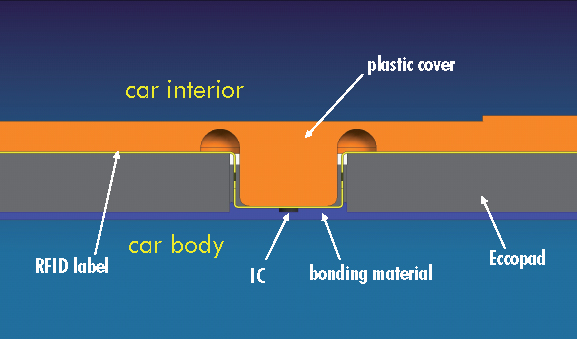
After looking at direct mounting, TNO decided that the use of an adhesive material to electrically decouple the tag from the vehicle was more reliable.
In the Netherlands, TNO has been exploring the use of electronic vehicle identification. The organisation's Igor Passchier talks to ITS International.
In the Netherlands, TNO, the independent research organisation, has been engaged in a project on behalf of the RDW, the Dutch vehicle registration and licensing authority, intended to look at the feasibility of using electronic means to make vehicle identification more accurate and less susceptible to fraud. Electronic Vehicle Identification (EVI) has been in existence in various forms for several years now but TNO was tasked with finding out whether OnBoard Unit (OBU)-based applications could be complemented by something more robust than the traditional licence plate and Vehicle Identification Number (VIN). The project included work to ascertain the best means of affixing battery-less Radio Frequency Identification (RFID) tags to a vehicle and the development of a method to use these tags to reliably and securely identify vehicles. The project ran from spring 2008 until earlier this year.The Netherlands' interest in EVI extends back to the 2002-3 period, says Igor Passchier, a Senior Consultant at TNO. This was then coupled to exploratory work for Road User Charging (RUC), where strong vehicle identification is a prerequisite. When that original RUC project was abandoned, so was the research into EVI. The work carried out in the last year is independent of the Dutch Government's current ambitions for a national road pricing scheme.
Addressing traditional shortcomings
In many respects, both the licence plate and the VIN are regarded as being insecure. The plate is especially prone to cloning and the VIN is unreadable by electronic means in its present form.Passive, battery-less RFID tags provide a means of identification which will last the lifetime of the vehicle. The use of multiple tags for an extensive list of applications is possible, although TNO has been using two applications for its developments.
"Several tag mounting criteria were taken into account," says Passchier. "The most important was the ease of aftermarket attachment but line of sight to a RFID reader was also a major consideration, as was the likelihood of a tag becoming detached or damaged during accidents.
"The door sill is a possible location but a tag mounted there is more likely to be damaged by people getting in and out of the vehicle. Mounting in the A-pillar allows easy electronic and visual access to the tag, while another tag can be mounted in a deeper, more secure location."
Tag integrity is another consideration given that it is being fixed to a metal surface. The TNO team looked at direct mounting, and using the entire vehicle as an antenna, but found this less reliable than the use of an adhesive material which electrically decouples the tag from the vehicle.
The tag was also designed to make any attempt at tampering immediately apparent. Passchier: "It won't simply break by itself but it also impossible to remove the tag without breaking it. And once it's broken it is rendered unusable."
Test conditions
The TNO team used one complete prototype with tags fully affixed. Much of the on-road testing was piggy-backed onto another project being run to look at an OBU-driven rush-hour avoidance application. Therefore, the tags in the remaining test vehicles, 23 in total, were merely carried. Testing took place over a period of months.The Netherlands has been looking at how rush-hour avoidance compares to, or can complement, RUC. There is, says Passchier, much of the 'stick' and little of the 'carrot' where RUC is concerned - drivers are in many senses penalised for using the roads at all, whereas if one can induce them to vary their journey habits then many of the same congestion mitigation effects can be achieved but without there being a sense of punitive action. Rush-hour avoidance is therefore more of a 'carrot' as drivers are incentivised financially to change the times of the day at which they travel.
The rush-hour avoidance tests were carried out using a GPS-enabled OBU with its own, internal identification; Passchier says that the rush-hour avoidance tests simply resulted in a convenient test-bed being available for the EVI tests.
"The EVI tests were conducted purely to ascertain whether the system is technically stable and an effective counter to fraud was possible," he continues. "The EVI solution as tested does not, for instance, offer guarantees for the correctness of the positional information. For that, you'd need some additional form of security."
Test results
Automatic number plate recognition was used as a control and EVI demonstrated a 95 per cent success rate."The system is still a prototype and we're still looking at that final 5 per cent," says Passchier. "There are a host of trivial prototype-related issues still to be addressed. For example, during vehicle start-up identification between the vehicle's tracking and EVI systems is not yet working fully. We don't expect to see any intrinsic problems within any final system although we have no data to back that statement at present."
Legal ramifications
TNO's solution has shown that the identification of vehicles and their owners can be properly effected, according to Passchier. However, there remain some legal issues which though not EVI-specific could have an impact upon any future deployment.For security reasons, sensitive information is not stored inside the vehicle. This creates the need for a central location where all relevant vehicle and personal details are kept.
This already exists and currently the RDW's data can be consulted in real time, online, 24/7. There is however a strict policy - laid down in Dutch traffic law - for the provision of data. Although there is in reality little difference between reading the number plate with automatic number plate recognition or EVI, there is a big advantage for the legal vehicle owner in that EVI makes the fraudulent use of identity much more difficult.
Next steps
Any effort to take EVI forward in a meaningful sense needs more support from government in general, not only RDW, Passchier says: "To be a success, in the end there needs to be at least a European solution. EReg is the Association of European Vehicle and Driver Registration Authorities, a cooperation dealing with subjects concerning registration and documentation of vehicles and drivers. EVI is a typical subject for EReg and, as a member of EReg, RDW will investigate if there is a desire for further study within the group."The European Commission looked at EVI in a project which ended back in 2004. The TNO/RDW project has effectively taken the Commission's work forward on a unilateral basis, as was one of the recommendations of the European project," says Passchier.
"The next step is to take this forward on a country basis, using a national scheme to provide an example of what can be done. We don't have a completed impact assessment as yet but taking the EVI forward in EReg seems a good step. I do think that we now have enough information to do so were such a decision taken to be forthcoming."












